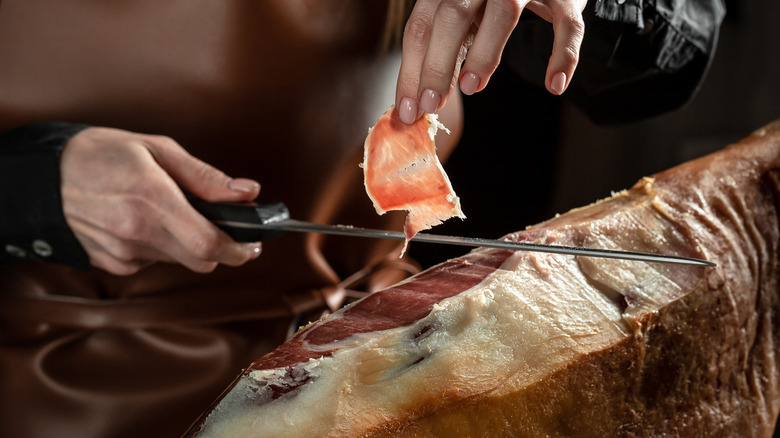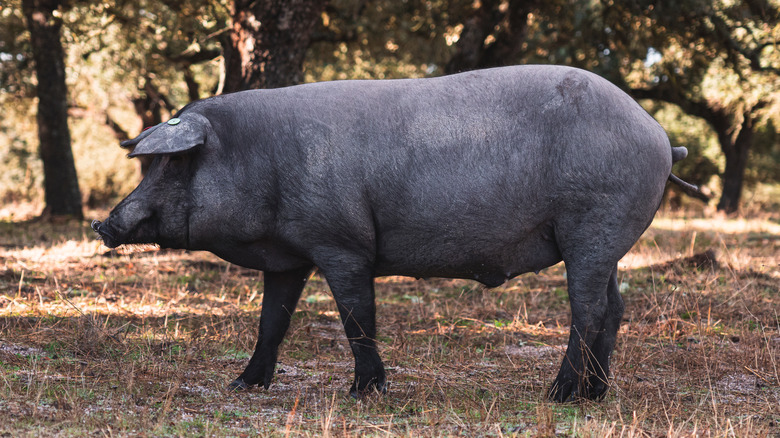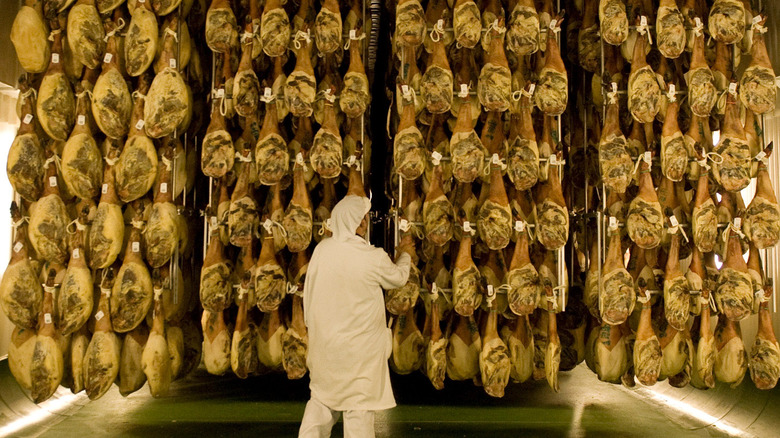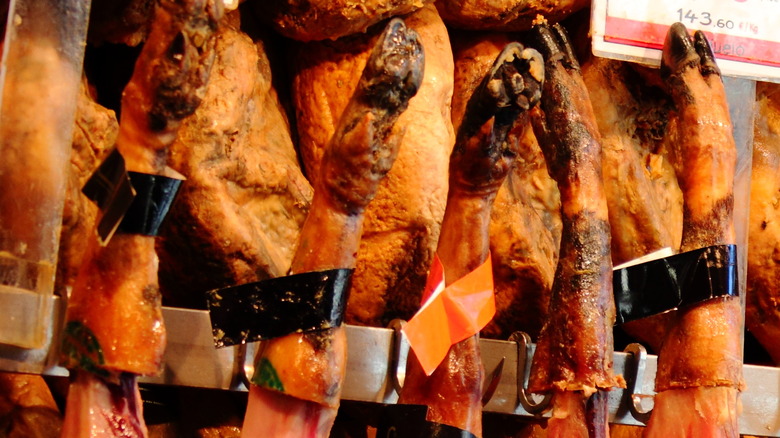The Extensive Process Behind Jamón Ibérico
The naive among us may be fooled into thinking that ham is just, well, ham. The same stuff that gets sliced and sold at supermarket delis is the exact same thing as that leg with the special tag on it that has aged for four years and costs thousands of dollars ... right? WRONG! There is a massive difference between that Honey Baked Ham your grandmother reheated at Christmas and the cultural, culinary significance of Spain's amazing(ly expensive) jamón ibérico.
Now, if Spain's own prime minister doesn't know the difference between serrano ham and jamón ibérico (via The Guardian), you're pretty much off the hook for not knowing yourself ... not really. The Spanish take their pork seriously. According to Food and Wine, Spain produces around 40 million hams every year. So, understanding the standard of quality that differentiates jamón ibérico from all other Spanish ham is essential if you plan on visiting the largest country on the Iberian peninsula any time soon.
It starts with the pig
It all starts with the pig. Or pigs. There are two different types of pigs that can produce jamón ibérico. The most prized, and certainly the most authentic, comes from the Iberian Pig, of which there are black, red, spotted, and light-skinned varieties (per Jamon). These pigs are descended from wild boars, which interbred with domesticated pigs brought to the Iberian peninsula by the ancient Phoenicians of the eastern Mediterranean. Iberian pigs tend towards obesity, developing healthy, foraging appetites that produce high amounts of intramuscular fat. Their diet consists mainly of the acorns of the sparse oak forests (dehesa) they populate. The acorns give the jamón its distinct, sought-after taste (via The Pig Site).
The acorn foraging Iberian is the standard upon which all other tiers of jamón ibérico are based. There is a tagging system — which we'll get into momentarily — that indicates the percentage of Iberian pig present in the finished product. Some jamón ibérico are the product of a interbreeding Iberian and Duroc pigs. According to Josep Llorens, the Duroc is the only breed allowed to mate with Iberians. The Duroc pig cannot be considered proper jamón ibérico on its own; the fat content of a Duroc is similar to that of the Iberian, which is why interbred pigs are considered comparable when it comes time for authentication.
The curing and aging process
The curing process after the pig is slaughtered is part of the same beautiful cultural dance that has occurred for generations. The foundation on which the legacy of jamón ibérico is built began with the yearly slaughter of the family pig. According to Jamon, the whole family was involved in the process. The entire pig was used to make everything from chops to chorizo and morcilla sausages. The legs, which are the cut for jamón, were set aside for special preservation.
Though the scale of production for jamón ibérico has increased dramatically, the curing and aging processes have remained virtually unchanged. The fatty legs of the pig are buried beneath mounds of salt, left to cure and absorb the salt for a couple of weeks. Then the legs are hung in a room with open windows for circulation and left to age anywhere from two to four years. The reason for this process, as Insider explains, is to allow the hams to sweat their fat that has absorbed the circulated mountain air, creating layers of flavor that give the meat its unique character (via YouTube).
The tag system
According to World Class, in 2014, the Spanish ministry of agriculture and fishing developed a new classification system for jamón ibérico as a way to ensure transparency and quality. The classification is broken down into a colored tagging system. White is the lowest classification, meaning the pig used was a mixed breed — at least 50% Ibérico — caged and fed on animal feed. The next level up is Green: 50% Ibérico, free range, and fed a mix of herbs and animal feed. Next is Red: 50%-75% Ibérico, free range, and fed on acorns. The final, highest label is Black: 100% Ibérico, totally free range, fed exclusively with acorns.
Red and Black tagged legs are called Jamón Ibérico de Bellota. "Bellota" is the word used to describe the special dehesa acorns that the pigs are exclusively fed upon. These top tier jamón are the ones that can sell for mad money, with a 13-pound leg running as much as $4,500 (per CNBC). It is this level of care, attention, and finery that makes jamón ibérico the crown jewel of Spanish pork products. And since we've now reached the end of our exposé, we must say congratulations! You now know more about jamón ibérico than the Spanish prime minister.



